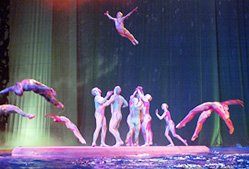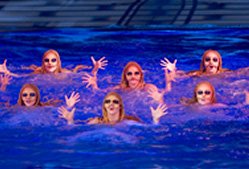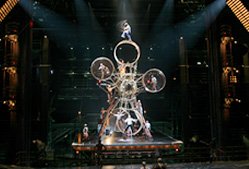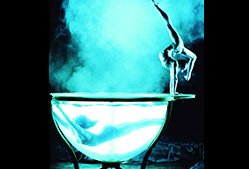YuYu interview Brigitte Bélanger Warner

| —— Nowadays everybody has heard of Cirque du Soleil, but it wasn’t always like that. How did you get your start? It started, in the early ‘80s, when a group of street performers from Quebec, decided to travel the world performing. It was through their travels they met other performers, learned new skills and joined together, traveling the world and entertaining people. The core of the group was from Quebec and the leader was Guy Laliberte’, an accordion player, stilt walker and fi re-eater, and the founder of Cirque du Soleil. In 1984, as part of the 450th anniversary of Jacques Cartier’s arrival in Canada, they were given a contract from the Quebec government to produce a portion of the entertainment. That was how and when Cirque du Soleil really began. It was a one time production, but from that the response was huge and so they decided to keep the show together and travel with this new circus. —— It is easy to understand that, especially back then, they had probably never seen anything like this! 
Mystere’s unrivaled imagination and showmanship has been entertaining sold-out crowds in Las Vegas’ Treasure Island since 1993. Photo by Tomasz Rossa, Costumes by Dominique Lemieux
© Cirque du soleil Inc.
Correct. There was no circus tradition in Quebec. The only circus that would come sometimes was the one with the animals etc. Ours was not a circus in the traditional sense because there were no animals...we relied solely on human performances and still do. So this was something completely new that blended comedy, theater, circus acts and street performing. It was brand new style of entertainment. —— So they kept the troupe together, where did they go from there? They were buskers, and they were just happy to do that at the time, but then when the success was so overwhelming they started to travel all over Quebec performing their show in a big top. As they did, they realized they had something special here and they started trying to figure out how to move beyond Quebec. Anybody familiar with Quebec know it’s not very nice in winter and not too many people want to be under a big top when it’s freezing outside! So they figured if they wanted the success to continue they would have to travel to warmer climates during the winter. Finally, in 1987 they had their chance. After several attempts to find a way to come to the States, they were given an opportunity to be the opening act for the Los Angeles Arts Festival. The show had to manage everything and to do its own publicity. It was a great opportunity, but also very risky. Really, it was do or die, because as legend has it, while they had enough funds to get to LA, if the show wasn’t successful, they didn’t even have enough money to put gas in the trucks to bring themselves, the show and equipment back to Quebec. Luckily, it was a tremendous success. The press was so positive and from that time on, Hollywood and the celebrities were fans of Cirque du Soleil. —— So winning over LA was the springboard to fame and fortune? Yes, because no one had seen entertainment like this before—everybody was fascinated. People wanted to do movies and we received several offers to sell the circus, but Guy was very wary about big business and careful not hand over control—to anyone. It just didn’t feel right and Guy had an intuition like nobody else in this world and he has always trusted that instinct. Artistic integrity was something that was not for sale, even when times were tough, and even today it’s untouchable. When we do something, we keep complete creative control, because that’s what we are all about. And that’s one of the trademarks of Cirque du Soleil. —— A street performer with street smarts and business intuition too? 
The colorful 75-member cast of Mystere takes a well-deserved bow. Photo by Tomasz Rossa, Costumes by Dominique Lemieux © Cirque du soleil Inc.
Absolutely! Guy and his partners always had a strong intuition and a flair for business and good luck. As the show continued to travel and grow, Guy realized that they needed to increase the size of their big top, since it was quite small in the beginning, to generate the income necessary to stay profitable. Even though times were tough, and while colleagues said he was crazy because they were having problems filling up an 800-seat tent, he gambled and put up a 2500 seat tent. And it worked! After LA, they continued to travel, even performing in San Diego, then on to Europe and then they came to realize that they could have more than one show traveling at a time. —— As you were growing and building on your success, how did you come to make Las Vegas your home? In coming to LA, and dealing with all of the Hollywood bigshots, Guy happened to meet Steve Wynn, the owner of the Mirage, who was looking for an attraction for the new hotel that he was planning, Treasure Island. So Steve approached Guy about the possibility of creating a brand new show to be performed in a resident theater at TI. So a deal was struck, but while the show was being created and the hotel and theater were being built, in ‘92 he offered Guy the opportunity to set up his tent in the parking lot of the Mirage to present a show called Nouvelle Experience and as they say, “The rest is history.” —— From the parking lot of the Mirage to your own theater in Treasure Island? Through the front door and into a brand new theater! The show we developed became Mystere and is still playing at the Mystere Theater to sold out crowds. Guy liked to say, “We wanted to grow a flower in the desert.” —— Before that, did Cirque du Soleil ever have a home? 
“O”, Cirque du Soleil’s spectacular water show, has been making waves at Bellagio. Photos by Tomasz Rossa, Costumes by Dominique Lemieux © Cirque du soleil Inc.
The big top was our home, because we were always traveling. So coming here (to Las Vegas) was the first time we ever had a fixed location or residence. It was a bit of a gamble on Steve Wynn’s part, but after all, this is Las Vegas! Up until that time entertainment on Las Vegas Blvd. consisted of a lot of showgirls with feathered costumes, and more traditional headlining singers or comedians. And while there is nothing wrong that, they are still beautifully performed here on the strip, Cirque du Soleil offered something else to visitors. In fact, people have credited us with basically reinventing entertainment on Las Vegas Blvd. —— What would you say is the common thread that makes a Cirque du Soleil production? Let me put it this way, it’s like when a parent has different children; you can see the family resemblance, but they each have their own unique personality. You can definitely see in all shows the attention to detail, the care that is put into the costumes, the high caliber of the performers and acrobats that we present. They also appeal to people from every culture. With the exception of Zumanity we seldom use spoken language in our shows. They are more about a mood that we are creating with the performance, visuals and music and how that evokes emotion in the hearts and souls of our spectators. So it really doesn’t matter if you are from Japan or Switzerland, you will find something…something that will touch you in each of our shows; something will speak to you. We think of it as live performance at its best. There is no use for us to duplicate what we do in the same city, if we did we’d only be competing with ourselves —— What are the shows that you are currently performing in Las Vegas? 
Photos by Tomasz Rossa, Costumes by Dominique Lemieux © Cirque du soleil Inc.
Mystere at Treasure Island was our first official resident show and before that we had been performing in the parking lot of the Mirage. From there our partnership with Steve Wynn was so successful, that when he began planning the Bellagio, he came to Cirque du Soleil, yet once again, and asked Guy about a doing a water show. Of course, Guy loving a challenge, said, “No problem.” And then began the 3-year process of research and development, which eventually led to the opening of “O” on October 15, 1998. In addition to those two we also have Zumanity at New York New York and our latest show KA at the MGM Grand. There is also another show, yet to be named, coming this summer, which is being developed around the Beatles. The performers are busy training in Montreal, fine-tuning the show as we speak. We can’t wait to see it. That will be opening at the Mirage and it is the first project that is actually fully endorsed by the Beatles: Paul McCartney, Ringo Star and the widows of John Lennon and George Harrison. We’ve worked very closely with their representatives to make sure they are satisfied and that we are being true to their spirit and music. It won’t be like bringing back the Beatles, but you’ll feel their spirit here. —— In each show I’ve seen, even the stages play a dramatic part in each production. They really are part of the experience too, aren’t they? Absolutely. When the stage for Mystere was created, it was very technologically advanced and still is in some ways. The lifts were something that had never really been done in that way. Each time Cirque du Soleil develops a resident show, we are very much involved in the creation of the showroom. We have a vision and we have certain requirements, for certain acts, and need to convey a certain image. We are very much hands on in the designing and the building of our theaters. Basically, the hotel provides the venue and builds the showrooms to our specifications. After all these years, they completely trust us and know we are going to put on a show that will take your breath away. For “O” we built a stage with a pool of 1.5 million gallons of water and 7 different platforms that move up and down and allow dramatic reconfiguration of the stage from one second to the next. It had never been done before, but Guy loves a challenge. KA, our latest was 4 years in the making and has another groundbreaking stage. It weighs 175 tons, makes extensive use of computers and hydraulics, and that allows it to do things never before done with a stage. You’ve really got to see to believe it. The show itself has 80 cast members, but behind the scenes there are 170 technicians supporting them. —— That’s a lot of people. I think at the final curtain call, when you see all of the cast, you really begin to appreciate how many people are involved. Do all the shows have so many performers? 
The cast of“O”walking on water. Photos by Tomasz Rossa, Costumes by Dominique Lemieux © Cirque du soleil Inc.
Our shows have anywhere from 55 in Zumanity to 85 in “O”. Still, each performer in a show has 3-5 different looks that they wear on stage. A “look” might be to be just a character passing through on stage or it might be part of an act. We also have what we call the house troupe, which do many things during a show and then there are the specialists: trapeze artists, etc. who they do their specialty and who also appear as other characters, but not as demanding. So our performers are very busy during a show. —— The costumes are fantastic and really help set the mood, where do they all come from? Some of our most talented people are behind the scenes in our workshops, where every costume for every show, is sewn by hand. All the costumes, shoes, wigs, are all custom made with most being produced in our Costume Workshop. We even dye and paint our own fabrics and we hand make the wigs and even the shoes. It’s a lot of work especially for a show like “O” where the costumes have to be replaced nearly every month because the chlorine in the pools eats away at the Lycra. That’s why we have over 300 full-time people working away in our Costume Workshop. —— With all of these resident shows and all the traveling shows, how do you find all of this amazing talent? Or do they find you? Very good question. We have a growing casting department that is composed of about 40 people. They are based in Montréal, but they are constantly traveling the world. They go to all the major competitions: the Olympics, major dance festivals—they are constantly looking out for the crème of the crop! They may even find talent in the subway. That’s how we found one of our guitar players. We have a number of former Olympians too. We provide a second life for so many of them once their competitive days are over. So it really varies quite a bit, but because of what we do every type of performer is welcomed, because it’s the blend of talent, culture and performance. —— How is it that you transform these competitors from so many cultures into performers? 
KA, Cirque du Soleil’s latest show at the MGM Grand, draws beautifully on many Asian inspired themes, costumes and music. Photo by Tomas Muscionico, Costumes by Marie-Chantale Vaillancourt © Cirque du soleil Inc.
While it’s true, many of them come from a very high caliber of competition and many have been to the Olympics, where they must perform their specialties in a very rigid, technical way—when they come to Cirque du Soleil they need to unlearn all of that. Whatever it is they do, a triple jump or high dive, they need to have an intention. Obviously the technical element is very important, but they need to be able to open themselves up to the audience and convey emotions and touch people. We teach them and help them refine their showmanship, so they can do just that. To do that most are sent to the Creation Studio at our international headquarters in Montreal for a few weeks or months of preliminary training before joining a show. There we’ve got over 20 trainers who specialize in dance, theater, singing and acrobatics. For many, that is the most difficult thing when they join our troupe. —— Your shows draw on so many different cultures. I understand you have a former Japanese Olympic athlete, Miho Kawabe, performing in “O”. Absolutely. Miho joined us over three years ago and she’s made such a nice addition to our synchronized swim team. In her Olympic days she won a bronze medal in synchronized swimming and helps to balance the squad which is composed mainly of Canadians and Americans. Nearly a dozen members of “O “ are former Olympians. We at “O” also have over 20 different cultures represented, so of course they bring a lot of their culture, customs, habits and personality to the show…and that is true for all of our shows. Our approach has been very simple, it’s about creating a universal language that’s attractive to people from all over the world. I think it is that blend of cultures that touches people and it is the perfect example of people from all over the world coming together. —— I understand, that in addition to all of the great shows you put on here and around the world, the founders never forgot where the came from and do what they can to give back. 
One of the numerous brilliant settings so ably conjured and brought to life within KA. Photo by Tomas Muscionico, Costumes by Marie Chantale Vaillancourt © Cirque du soleil Inc.
That’s right. Cirque du Soleil has outreach programs that are very dear to the founding president, because he comes from the streets. Throughout his adventures, he never forgot his beginnings and like to help the community. The biggest and best example I can give is called “Cirque du Monde” which is “Circus of the World”. Through this we have a certain number of coaches, throughout the world, and they teach street kids circus arts. What that does is to help these street kids with their self-esteem and help them, in many cases, to find their place in society and value themselves. It’s been a very successful program for over 10 years now and is active in South America, Europe, in Asia, here in Las Vegas and in Montréal. It’s a great feeling to hear the success stories of kids that we’ve helped, some of which have actually become performers in some of our shows! Others have gone on to become coaches in “Cirque du Monde” programs themselves and have come full circle by continuing to help others. It is just a wonderful program and for Guy, it is really important. It’s a mandate that he has really given himself to. —— What does the future hold for Cirque du Soleil? 
Zumanity, showcases a more adult themed side of Cirque du Soleil’s assault on the senses, at the New York-New York Hotel & Casino. Photo by Phillip Dixon, Costumes by Thierry Mugler © Cirque du soleil Inc.
We are always receiving offers and always looking for ways to expand what we do. Besides the coming new show, that will open at the Mirage this summer based on the Beatles, we are always evaluating ways to take what we do into other venues. We have a division called Cirque du Soleil Image, which is responsible for, among other things, the production of TV specials, documentary, reality series, but most of those projects that haven’t come to life yet. When it does happen, whether it is a hotel, a taxi cab or a new show, we will take that opportunity to play with your senses and to create that mystique… something different than you are used to. Maybe someday there will be a Cirque du Soleil hotel, but whatever it is, it will always be true to the founder’s vision, heart and soul. (04-01-2006 issue, Interviewed by Terry Nicholas) |

